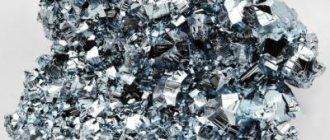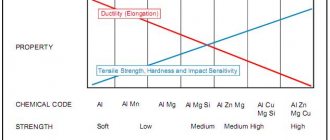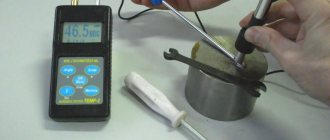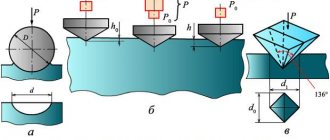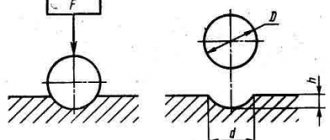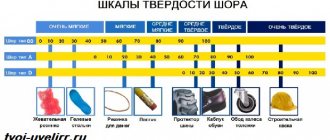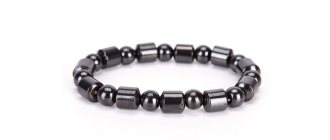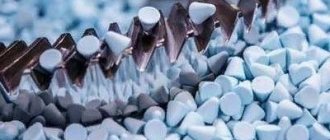Rock Density
Mineralogists determine the type of stone by density and hardness. When excavating deposits, the second method proposed by F. Moos is used.
The type of stone is determined by a consistent assessment of its hardness, shine, fracture surface, color, color of the line (mineral powder), and other qualities.
The density of a stone is the ratio of its weight to the mass of water of the same volume. Determined in laboratories by hydrostatic weighing or immersion in heavy water (saturated liquid HgI2BaI2).
Density is assessed on a 20-point scale. Stones with values of 1 and 2 always lie in the surface layers, and those with values above 10 are located in the depths of the deposits. The latter include diamond, sapphire and ruby corundum, and other precious minerals.
The hardness of a stone is the degree of its resistance to mechanical damage. To find out, the found mineral is scratched, squeezed or pressed onto a small area.
What does hardness depend on:
- crystal cleavage;
- internal integrity of the mineral;
- percentage of quartz;
- type of secondary impurities;
- origin of the stone (how it was formed).
Less hard stones are those whose crystals are weakerly welded together, have more loose impurities, and have cracks or other defects inside. The Mohs method is used to evaluate the approximate cleavage, species, and durability of the gem.
By comparing the relative Mohs scale readings with the minerals they find, geologists understand the best way to mine the rock. Jewelers use these same values to select tools for polishing and cutting. Sellers and buyers of gems determine its authenticity, durability and care methods.
Species by origin and composition
List of organic formations
Each classification includes a division of stones and minerals by origin. There are organic, endogenous, exogenous and metamorphic formations. They differ from each other in composition, density, shades, formation period and other characteristics.
Organic rocks include fossils of various types that were once living organisms or that arose as a result of biological processes. Representatives of the group have the following names:
- ammonite;
- nacre;
- coral;
- pearl;
- amber;
- Ivory;
- jet;
- belemnite (or devil's finger);
- petrified wood.
Each of them has a unique history of origin and properties. It took several millennia for some of the stones that were once part of the living world to form. However, many are able to form within 7–10 years.
Stones of endogenous origin
The endogenous process takes place in the depths of the earth's surface. The stones are formed from a silicate fiery liquid melt called magma. There are many representatives of the group, but not everyone is used in jewelry. Often the choice of specialists falls on quartz, which is shown in the photo. It is distinguished by its hardness, resistance to water and alkalis.
Exogenous formations
An exogenous process is characteristic of the surface of the earth's crust; rocks are mined on land and in the sea. For the formation of crystals, weathering is necessary, after which several groups appear at once: hydromica, kaolinite, halite, opal, sylvite. Some are the result of the vital activity of marine life and plant organisms. All exogenous formations have properties different from other minerals. They are relatively soft and do not tolerate contact with water and acids.
Metamorphic minerals
The formation of metamorphic types of minerals occurs under the influence of certain factors in the earth's crust. Some require high temperatures and pressure changes, others require magmatic gases or water. To begin the process, previously formed exogenous samples are required. As a result of metamorphic formation, minerals become stronger and acquire high density.
What is the Mohs hardness scale
Friedrich Moos developed a 10-point scale for the hardness of different rocks. It included 10 minerals of reference strength. The lower the indicator, the less durable the gem, the easier the method of mining, cutting, and the labor intensity of the work.
Mineral hardness table:
| Reference samples | Score as suggested by Friedrich Mohs |
| Diamond | 10 (highest) |
| Corundums (sapphire, ruby, emery, others) | 9 |
| Topaz | 8 |
| Quartz | 7 |
| Feldspars | 6 |
| Apatite | 5 |
| Fluorspar, fluorite | 4 |
| Limestones, calcites | 3 |
| Rock salt, gypsum | 2 |
| Talc | 1 |
These gems are used to test the density of crystals. If they do not damage the surface, it means that the sample being examined is either harder or identical to the reference sample.
There are gems with intermediate strength that are not included in the Mohs scale. The indicator is written as a fraction or decimal number.
Linear hardness is also determined. The load on the gem is done along the trajectory of one conditional line. That is, they mechanically influence the surface under study along, across or deep into the crystal. The values are checked not according to Mohs, but with an absolute scale.
Linear strength scale indicators:
- diamond - 1500;
- corundum - 400;
- topaz - 200;
- quartz - 100;
- orthoclase, feldspar - 72;
- apatite - 48;
- fluorite - 21;
- calcite - 9;
- gypsum - 3;
- talc - 1.
For field conditions there are no fundamental differences between the scales. Diamonds are not damaged by any material. Talcum powder and plaster leave fingernail marks. Corundums scratch topaz. Quartz leaves marks on window glass. Fluorite and apatite are checked with a knife, and calcite is checked with a copper plate or coin.
The principle of working with the scale
The density of the mined rock is performed using Mohs pencils. This is a set of 10 reference stones. A specimen mineral with a pointed edge is fixed in a metal rod for convenience. Each pencil is marked from 1 to 10 according to the Mohs hardness scale (from talc "1" to diamond "10").
The peculiarity of the work lies in the mechanical effect of the pencil on the rock under study. A stone with the highest hardness will always scratch a sample with a lower hardness and will not damage a gem with a higher hardness.
Example 1. A sample marked “9” will damage gems with a density below 9 (from topaz to talc). The stone to be tested is placed on a flat surface with its whole side up and scratched with force with a hardness standard. If the crystal remains intact, it either belongs to corundum (sapphire or ruby) or belongs to diamond. The latter will not be scratched by any of the pencils.
Example 2. The test stone is scratched alternately with pencils with increasing numbering. Start with the number “1”, “2” or “3”. Hardness is determined using a reference sample that has not scratched the rock.
What is salt
The chemical formula of this substance is as follows: NaCl. Table salt is also called sodium chloride or rock salt. When crushed, this food product appears as colorless crystals. The latter may have different sizes. In any case, salt in bulk is white.
The main feature of sodium chloride, as is known, is its characteristic taste. In everyday life and in the food industry, table salt can be added to a variety of products. As scientists have found out, sodium chloride is a substance without which human life is completely impossible.
Classification of natural stones by hardness
The hardness of reference minerals is indicated in the Mohs table. The species of samples with the same indicator is distinguished by appearance and physicochemical properties.
The diamond has the highest score of “10” and cannot be scratched by anything. Sapphire and ruby corundums are assigned the marker “9”. Can only be processed with diamond tools.
If a gem can be drilled through concrete, it is alexandrite, chrysoberyl and other rocks with an index of less than 8.5 points. The steel nail damage indicates possible rocks below the quartz marker "7".
A carbon steel knife will not damage orthoclase, but will scratch monazite, malachite, mica and other minerals with an index of less than 5.5. Belonging to calcite is checked with the edge of a copper coin. Gypsum and talc are the softest rocks. They scratch with a fingernail.
List of gems with an intermediate indicator:
| Minerals outside the Mohs scale | Decimal exponent | Fractional value |
| Moissanite | 9,5 | 9 ½ |
| Unpolished porcelain tiles, choltite, alexandrite, chrysoberyl | 8,5 | 8 ½ |
| Tungsten, ganite, aquamarine, spinel, emerald, painite, beryl | From 7.5 | From 7 ½ |
| Zircon, sapphirine, andalusite | 7,5 | 7 ½ |
| Almandine, danburite, tourmaline, boracite, cordierite | Up to 7.5 | Up to 7 ½ |
| Silicon, granite, jadeite, jasper | 6,5 | 6 ½ |
| Monazite | 5,5 | 5 ½ |
| Malachite, chalcopyrite, dolomite | 3,5 | 3 ½ |
| Cinnabar, amber, bismuth, chlorite, mica | 2,5 | 2 ½ |
| Graphite | 1,5 | 1 ½ |
According to the Mohs scale, samples are divided into soft, medium and hard minerals. The first group includes graphite, gypsum, talc, cinnabar, mica and other stones with a score below three. The second class includes breeds with an indicator of 3–6. The rest are considered the most durable. The density of precious gems is called a value from 8. These are topaz, sapphire, ruby, diamond.
To view a review on the topic:
Basic physical properties of minerals
Let us consider the main parameters by which the main physiological qualities of minerals are determined.
Shine
This is the reflective ability of rock. In science there is no strict definition of such a concept as shine. For example, pyrite and galena are opaque minerals that have a pronounced metallic luster because they reflect light well.
There are rocks with a polymetallic luster - transitional from metallic to non-metallic.
Minerals with a non-metallic luster are transparent or colored in various shades.
Cleavage
This parameter is determined by the qualities of the crystal lattice and the strength of adhesion of the elements inside it. There are several types of cleavage:
- very perfect - mineralized rock can be easily split into separate plates with sparkling, smooth surfaces;
- perfect - splitting occurs after a light blow, from which the rock crumbles into small pieces with shiny, smooth edges;
- medium - the mineral under mechanical action forms not only straight planes, but also fractures with uneven edges;
- very imperfect - complete absence of cleavage in the mineral.
Color
This indicator is due to the presence of impurities in the mineral or its chemical composition. Today, it is not entirely clear why gems appear in different colors, since the same chemical component colors different minerals in different shades. For example, chromium makes emerald greenish and ruby bright red.
Density
This is the specific gravity of the mineral. Density is the ratio of mass to volume (g/cm3), the denser the structure of the rock, the heavier it is.
Hardness
This is the degree of resistance of a mineral to the penetration of a foreign object into its structure. The bulk of mineralized rocks have a hardness of 2 to 6. The hardest are silicates and anhydrous oxides. The study and further description of the properties of minerals is necessary for their most effective use by humans.
What are gems, what types are they?
Gems are considered to be transparent and opaque minerals or rocks. They are divided into three categories: precious, semi-precious and ornamental. Most occurred as a result of volcanic activity and the formation of mountain folding. They absorbed the power of the four earthly elements and waited for thousands of years for the hour when they would fall into the hands of people.
The name "gems" does not refer to scientific terms. It has been used in the Urals since the 18th century and received practical application in the 20th century thanks to the works of the mineralogist A.E. Fersman. According to the classification developed by the professor, gems are transparent stones from the category of precious and ornamental. He classified all opaque minerals and rocks as “colored stones.”
Any classification of nuggets by color, transparency, cost, or application is conditional. Depending on the quality, the same mineral can be classified as precious and ornamental stones.
Gems
Precious minerals include finely cut or polished minerals, which are distinguished by their rarity, durability and spectacular appearance. Their weight is measured in carats, and their value is determined by criteria such as purity (no impurities), uniqueness and demand.
The most famous nuggets:
- diamond (cut diamond) (Mohs hardness - 10 out of 10);
- corundum ruby, blue sapphire (hardness - 9);
- chrysoberyl, alexandrite (hardness - 8);
- beryl aquamarine, emerald, sparrow (hardness - 7.5-8);
- spinel (hardness - 7.5-8).
Semiprecious stones
Semi-precious nuggets are those that are popular in jewelry, but are not rare or expensive. Their hardness is lower than precious ones, but in beauty they are in no way inferior, and sometimes even superior to their older “colleagues”. Jewelers value them for their transparency, hardness (6.5-7.5 points) and ease of cutting. The most popular semi-precious nuggets:
amethyst – blue, bluish-pink, purple quartz (see photo);
- garnet - crystals from red to dark, almost black;
- citrine - lemon-yellow or honey-colored quartz;
- topaz - aluminum silicate, available in many shades - blue, pink, yellow, golden;
- chrysolite is a magnesium iron orthosilicate with a warm golden-green or cool emerald hue.
Ornamental specimens
Ornamental samples include poorly translucent and opaque samples of nuggets and mineral bodies with a colored pattern.
The most revered by masters:
- Jasper. Dense particles of quartz combined with silica and clay. It can be variegated, uniform, striped. Color - brown, blue, olive, depends on impurities.
- Malachite. Basic copper carbonate with a rare emerald green hue and a pattern of thin graceful veins. A product of weathering of copper ores, their constant companion.
- Chrysoprase. A variety of quartz and chalcedony with nickel impurities. The color of the stone is described as apple, bluish-green. Occurs in the form of small grains.
- Charoite. Chain silicate and the rock of the same name are purple, lilac, light brown.
- Chalcedony. A fine-fibered variety of quartz. Color - from white to honey yellow.
- Cornelian. A variety of chalcedony, has a red or orange tint. The structure is fibrous, consisting of thin layers of quartz.
- Nephritis. White, gray, green amphibole with high impact strength. Samples with a single color are valued higher than “cloudy” or striped ones.
Strength values of precious minerals
The hardness test is good for distinguishing rare beautiful crystals from their glass or artificial imitations. Precious stones include natural minerals in natural or processed form - diamonds (diamonds), sapphires (blue), rubies, emeralds, alexandrites.
Synthetic analogues of precious stones are grown under special conditions. Such gems are much cheaper. Unscrupulous manufacturers make jewelry from artificial crystals or jewelry glass of the required color, and then offer them at the same prices as natural ones. A well-known imitation is cubic zirconia. It is very similar to a diamond, but its cost is not comparable to natural stones. It’s easy to identify a fake by finding the Mohs hardness:
- when a sapphire has a value of 7, then there is a high probability that the cabochon is made from quartz;
- If in a diamond’s passport the strength index is 8.5, but it should be 10, it becomes clear that this stone is not of natural origin (cubic zirconia has an index of exactly 8.5).
| Crystal | Mohs hardness | Crystal | Mohs hardness |
| Ruby | 9 | Agate | 6,5―7 |
| Alexandrite | 8,5 | Jasper | 6―7 |
| Spinel | 8 | Amazonite | 6―6,5 |
| Topaz | 8 | Nephritis | 6―6,5 |
| Aquamarine | 7,5―8 | Rutile | 6―6,5 |
| Beryl | 7,5―8 | Rhodonite | 5,5―6,5 |
| Pyrope | 7,5―8 | Obsidian | 5―5,5 |
| Tourmaline | 7,5―8 | Purpurite | 4,5 |
| Zircon | 6,5―7,5 | Corals | 3―4 |
The Mohs hardness scale, despite the relative results, remains the main tool in geological surveys. In the field, every kilogram of weight carried is recorded, and to identify an unknown rock sample, a simple knife and glass is enough.
Information on the hardness of minerals in most reference books is given in relative values. A narrow circle of specialists is interested in absolute values. Another area of primary use of the Mohs scale is jewelry making. Based on the hardness of the crystals, they choose the method of processing the stone, the grinding option and the machines and tools needed for this.


